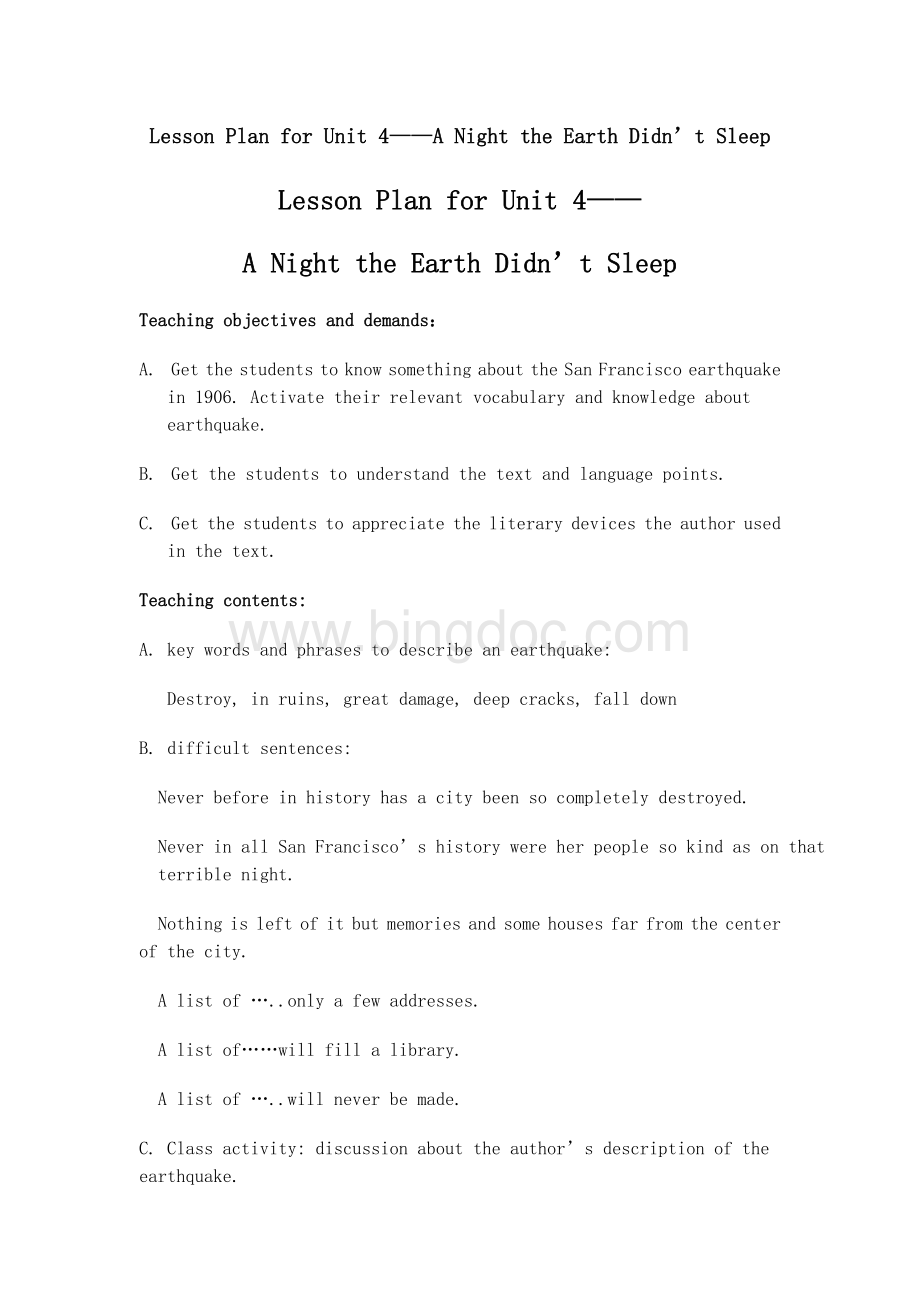A-Night-the-Earth-Didn’t.doc
《A-Night-the-Earth-Didn’t.doc》由会员分享,可在线阅读,更多相关《A-Night-the-Earth-Didn’t.doc(13页珍藏版)》请在冰点文库上搜索。

LessonPlanforUnit4——ANighttheEarthDidn’tSleep
LessonPlanforUnit4——
ANighttheEarthDidn’tSleep
Teachingobjectivesanddemands:
A. GetthestudentstoknowsomethingabouttheSanFranciscoearthquakein1906.Activatetheirrelevantvocabularyandknowledgeaboutearthquake.
B. Getthestudentstounderstandthetextandlanguagepoints.
C. Getthestudentstoappreciatetheliterarydevicestheauthorusedinthetext.
Teachingcontents:
A.keywordsandphrasestodescribeanearthquake:
Destroy,inruins,greatdamage,deepcracks,falldown
B.difficultsentences:
Neverbeforeinhistoryhasacitybeensocompletelydestroyed.
NeverinallSanFrancisco’shistorywereherpeoplesokindasonthatterriblenight.
Nothingisleftofitbutmemoriesandsomehousesfarfromthecenterofthecity.
Alistof…..onlyafewaddresses.
Alistof……willfillalibrary.
Alistof…..willneverbemade.
C.Classactivity:
discussionabouttheauthor’sdescriptionoftheearthquake.
Importantpointsanddifficultpoints:
A. Importantpoints:
² Activatethestudents’relevantvocabularyandknowledgeaboutearthquake.
² Improvethestudents’abilityofanalyzingthetextandgetthemtodeveloptheskillsofobtainingthemainideaofthetextinthelimitedtime.
B. Difficultpoints:
² Getthestudentstounderstandsomedifficultsentences.
² Guidethestudentstoappreciatetheliterarydevices.
Teachingapproach
A. Task-basedlearning
B. Activity-basedteaching(classwork,individualwork,groupwork)
Teachingaids
PowerPoint
Timeallocations
Step1.Lead-in(2minutes)
Step2.Pre-reading(5minutes)
Step3.Fast-reading(8minutes)
Step4.Intensivereading
Step4.1difficultsentences(10minutes)
Step4.2literarydevices(8minutes)
Step5.Discussion(5minutes)
Step6.Homework(2minutes)
Teachingprocedures:
Step1 leading-in
A. Relatethisstorytothepreviousreadinganighttheearthdidn’tsleepandleadinnaturally.
B. Introducesomethingabouttheauthor.
Rationale:
getthestudentstohaveashortreviewofwhattheyhavelearntbeforeandactivatetheirexistingknowledgesothattheywillhaveawholeconceptofthisunit.
Step2 pre-reading
A. GivethestudentssomebackgroundknowledgeabouttheearthquakeinSanFranciscobyshowingthemsomepictures.
B. Askthestudentstodescribethepicturesintheirownwords.
Rationale:
Activatethestudents’relevantvocabularyandknowledgeaboutearthquakeandmakeitlessdifficultforstudentstofurtherunderstandthetext.
Step3 fast-reading
A.Askthestudentstoreadthepassagequicklyandthinkaboutthefollowingquestions:
• What’sthemainideaofeachparagraph?
• Howdidtheauthorfeelabouttheearthquake?
• Howdidtheauthorfeelaboutthepeopleduringtheearthquake?
B.checktheanswers(theiranswersmayvary)
C. Guidethestudentstofindproofsinthetext.
Rationale:
getthestudentstofindoutthemainideaofthetextandtheauthor’sattitudeexpressedinthetext.
Step4 Intensive-reading
Step4.1 DifficultSentences
1.Neverbeforeinhistoryhasacitybeensocompletelydestroyed.
2.NeverinallSanFrancisco’shistorywereherpeoplesokindasonthatterriblenight.
A.Introducetheconceptofinvertedsentence,askthestudentstoreadthefirstparagraphandfindoutsentence1.
B.Putsentence1inthenormalwordorderandexplainitsmeaning.
C.Askonestudenttoputsentenceinthenormalwordorderandexplainitsmeaning.
Rationale:
getthestudentstoknowthemeaningofthesentencessothattheywillnotbeanobstacleintheirunderstandingofthetext.Encouragethestudentstoexplorebythemselves.
3.Nothingisleftofitbutmemoriesandsomehousesfarfromthecenterofthecity.
Dividethesentenceintotwopartsandexplaintheminthedetailedway.
Rationale:
thisoneisalittlebitdifficulttounderstand.
4.Alistof…..onlyafewaddresses.
5.Alistof……willfillalibrary.
6.Alistof…..willneverbemade.
Explainthethreesentencesroughly.
Step4.2 LiteraryDevices
Introducethestudentssomeliterarydevicesusedinthearticle:
Negativewords/Repetition/Contrast/Parallel
1. Negativewords
a. listthreesentencesonthescreenandinviteonestudenttothereadthemandaskhimwhetherthethreesentenceshavesomethingincommon
b. Askstudentswhytheauthorputnegativewordsatthebeginningofthesentence.
2. Repetition
a. askthestudentstofindoutonewordthathasbeenrepeatedagainandagain
b. listthemonthescreenandexplainthecomplexsentenceAllofthewaysmanhadmadetokeepthecitysafeweregoneinthethirtysecondstheearthmoved.
c. Askthestudentswhytheauthorusethewordgonesomanytimes
3. Contrast
a.askthestudentstofindsomesentencesinwhichtheauthorusescontrasttodescribethepeopleintheearthquake.
b.listthemonthescreenandanalysisthecontrast
c.explaintwoofthesentencesthataredifficulttounderstand:
Amazingasitmayseem,Wednesdaynightwasaquietnight...
NeverinallSanFrancisco’shistorywereherpeoplesokindasonthatterriblenight.
(Languagepoints)
4. Parallel
a.askthestudentstofindouttheparallelsentencesinthethirdparagraphandtrytounderstandthem.
b. Listthethreesentencesandasksomestudentstoexplainthemintheirownwords.
Rationale:
helpthestudentstoappreciatesomeliterarydevicesemployedbytheauthorandrefertoitintheirownwriting.
Step5 Discussion
• Howdoyouthinkofthewriter’sdescription?
• Doyoubelieveit?
Giveyourreasons.
Step6 Homework
Askthestudentstolistentotapeandpracticereadingthethirdparagraphwithfeeling.
TeachingPlanforUnit3——Computers
Period4Reading—WhoAmI?
教学设计
ByZhouJin(周晶)鄂南高中
一、教学设计思路
本节课我采用自主型教学和任务型教学的方法,让学生对课文进行阅读理解。
自主型教学是学生在老师的指导下自主地进行学习。
任务型教学是英语新课标中倡导的一种英语教学方法。
根据新课标的规定标准及课堂教学设计的特点,本节课的设计思路如下:
导入:
教师首先以图片的形式复习有关电脑的词汇和计算机的发展历程,让学生看文章标题和图片来预测语篇的内容,培养学生的预测能力;并让学生讨论计算机的应用领域,为计算机产品按发展的时间顺序排队。
教师播放课文录音,请同学快速地阅读课文,并回答教师提出的与课文有关的问题。
然后让学生仔细阅读课文的每一段,回答教师设计好的问题和任务。
其间,教师让学生以不同的方式朗读课文。
然后,教师通过让学生进行短文填空的方式来帮助学生总结阅读课文,并检验他们是否理解文章。
最后教师布置一项讨论的任务,让学生用语言来表达出未来电脑的模样及应用,激发他们的想象力和兴趣,升华主题。
二、学习者分析
内容
收集数据的途径
学习者特征的描述
已有知识和技能
访谈,行为观察
初中所学的英语基础知识,
单词可以,语法不好。
过程和方法
访谈及观察
仍持初中英语学习方法,
渐渐适应高中学习。
态度/情感/
价值观
访谈,观察,
科学调察
课堂反映良好,
因为对新课程内容较感兴趣。
思想水平
访谈,观察
能够很好地配合教学,
但由于基础不是很好,
对学习方法正在探究阶段。
一般认知水平
查阅学习者档案,观察
基础不是很好,但都很努力,
有一定的自学能力。
三、学习任务分析
本单元主要围绕“计算机”这一中心话题展开,而本文题为“WhoAmI?
”,阅读文章以第一人称的拟人手法介绍了计算机发展演变的历史和计算机在各个领域的应用,让学生了解了计算机的发展变化之快以及在生活中用途之广。
目标:
1、锻炼学生的阅读能力
2、使学生了解更多计算机的相关信息知识,学到与此有关的一些语言知识并能清晰地了解作者的写作思路,从而实现阅读文章理解的三个维度:
信息知识、语言知识和语篇知识。
3、激发学生的学习兴趣和想象力。
教学难点:
1、如何提高学生的阅读能力和如何使其能更好的理解课文。
2、怎样掌握文章的重点。
3、使学生能够积极讨论计算机的话题。
四、教学目标
理论依据:
《普通高中课程标准实验教科书》
根据新课标的规定及其高一学生的特点及基础,把本节课教学目标定为:
1、语言知识方面:
A.单词:
simplify,logically,reality,solveapplication,finance,explore
B.词组:
technological,revolution,artificial,intelligence,asaresult
2、语言技能方面:
使学生掌握和运用计算机的有关词汇及表达法,可以较好地运用并
进行关于计算机发展和应用话题的交流,提高读及说的技能。
3、学习策略方面:
A.兴趣策略:
用图片提高学生学习兴趣,听录音使学生产生模仿兴趣。
B.自主型学习策略:
通过提问让学生自己找答案,看谁找的又快又准。
C.任务性教学策略:
要求学生在理解文章过程中,讨论和编练对话。
4、情感态度方面:
A.通过激发兴趣方法,使学生积极参与课堂活动,产生强烈求知欲。
B.通过互动等方式,增进师生友情,达到进一步的信任。
5、文化意识方面:
通过学习,了解计算机发展演变的历史和计算机在各个领域的应用,从而让学生了解了计算机的发展变化之快以及在生活中用途之广,激发学生的学习兴趣和想象力。
五、教学设备
黑板,录音机,电脑,投影仪。
六、教学设计分析(TeachingProcedures)(40m/s)(下附详细过程)
七、资源与媒体利用
通过图片进行导入,引起学生的注意力,增进师生间的互动,提高学生用英语说话的欲望,让他们形成良好的语言习惯。
通过录音机和黑板的运用,使学生能够切身的体会到本文的内容。
教学设计分析(TeachingProcedures)
教师活动内容﹑方式
Step1Greetings
Greetthewholeclassasusual.
Step2Lead—in
Reviewsomenewwordsofcomputersbyshowingthemsomepictures.Thenpredictthecontentofthetext,knowaboutthedevelopmentofcomputersandtalkabouttheusesofcomputers.
Step3Reading
1.Skimming
Thestudentslistentothetapeandanswersomequestionsonthescreen.
Qs:
1).Whoisthespeakerinthisstory?
2).What’sthemainideaofthispassage?
3).Tellthefollowingstatementstrueorfalse.
2.Scanning
Thisisanindividualwork.Askthestudentstoscanoneparagraphbyoneparagraphtofindthedetailedinformation.Letthemanswersomequestionsandfillinachart.
1)Wherewereyouin1642?
2)Whatwereyoucalledin1936?
3)Whathappenedtoyouinthe1970s?
Time
Events
1642
Thecomputerbeganasacalculatingmachine.
1822
TheanalyticalmachinewasmadebyCharlesBabbage.
1936
Thecomputergrewrapidlybothinsizeandinbrainpower.
1940s
Thecomputerhadgrownaslargeasaroom.
1960s
Thefirstfamilyofcomputerswasconnectedtoeachother.
1970s
Computerswereusedinofficesandhomes.
Now
Computersconnectpeopleallovertheworldtogether.
Encouragethestudentstofindthesentencesinthetext.Theyshouldfinishthistaskbythemselves.
3.Carefulreading
Askstudentstofindthetopicsentenceofeachparagraphandthesupportingdetailstoeachone.
Para.1:
Ibeganasacalculatingmachinein1642inFrance.
1.calculatingmachine
2.analyticalmachine
3.universalmachine
4.laptop
Para.2:
Thesechangesonlybecamepossibleasmymemory
improved.
1.tubes
2.transistors